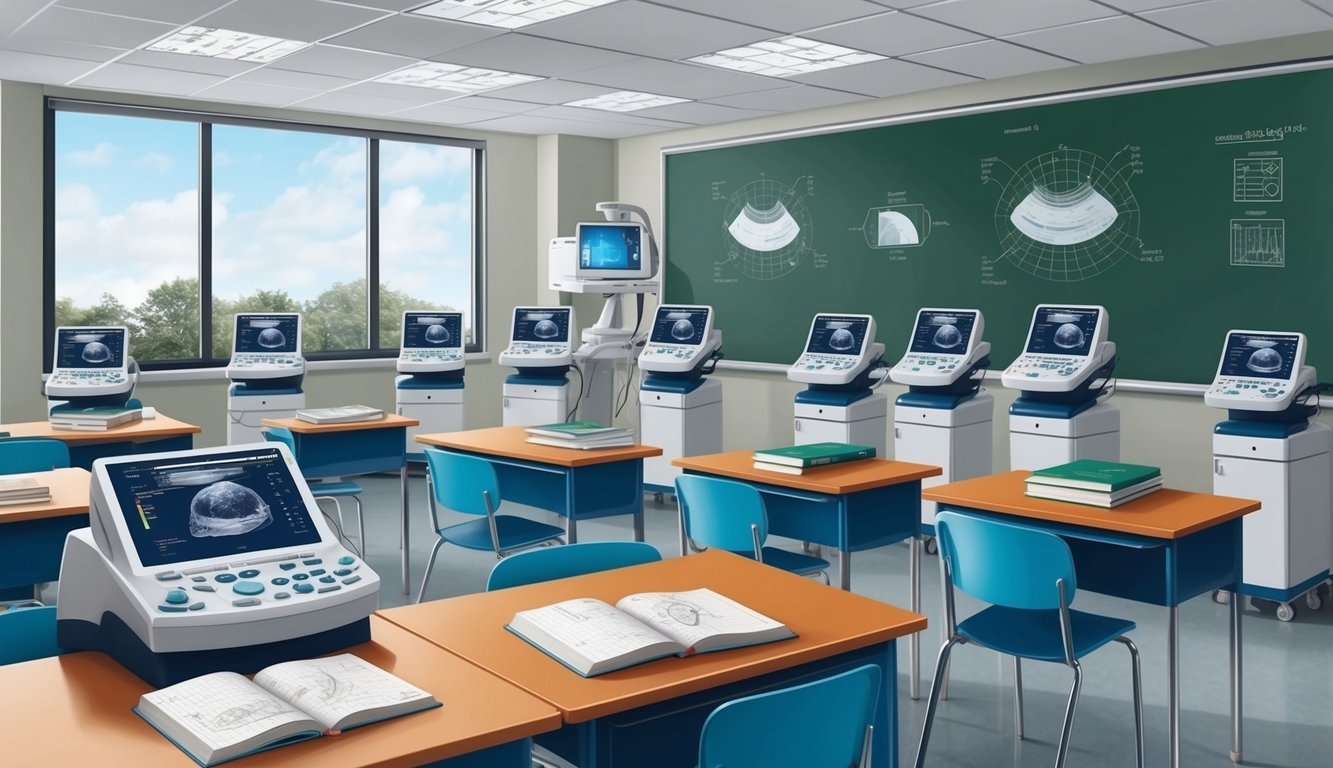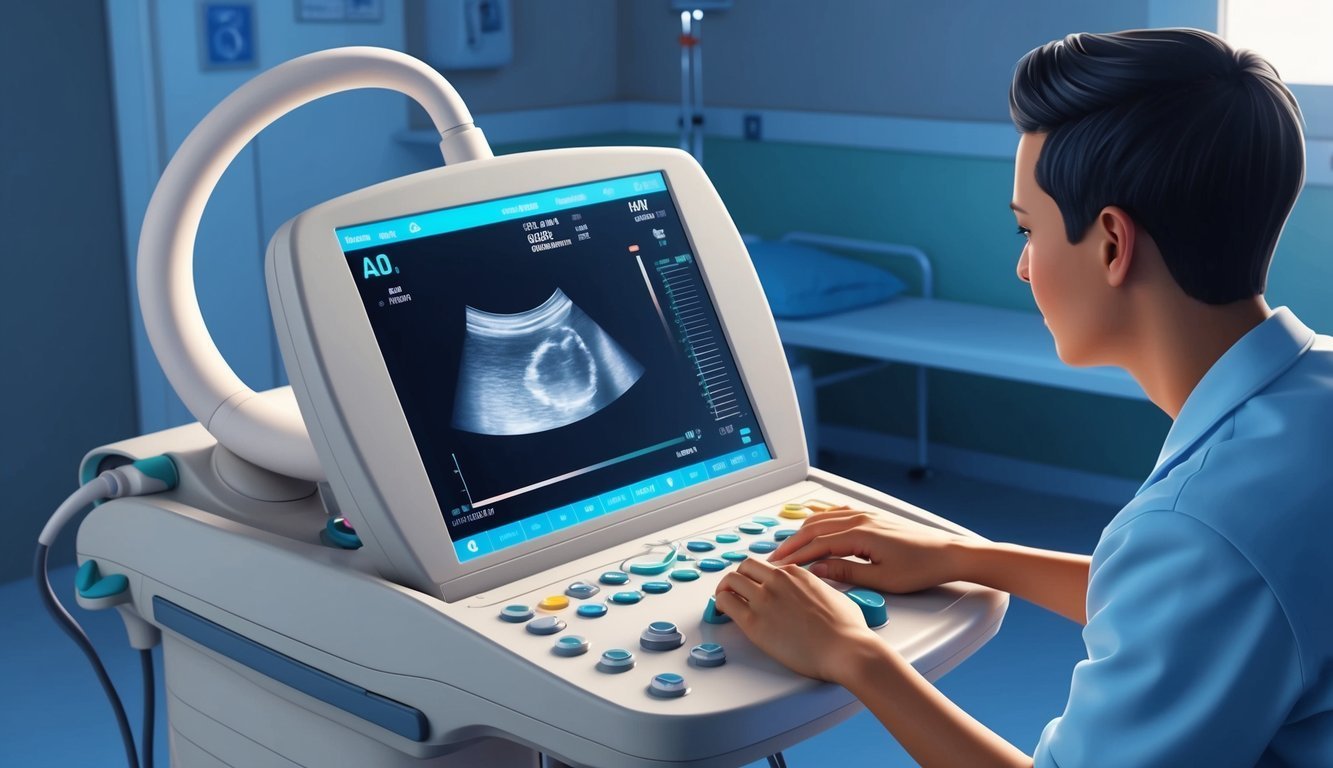Becoming an ultrasound technician is an appealing career path for those interested in healthcare and technology.
Typically, you will need to invest two to four years in education, depending on whether you choose an Associate’s or Bachelor’s degree program.
This commitment lays the foundation for a rewarding career in the medical field, where you will play a crucial role in patient diagnostics.
Many programs offer hands-on training alongside classroom instruction, ensuring that you acquire the necessary skills to excel in this profession.
Completing an accredited ultrasound tech program helps you become eligible for certification, which can significantly enhance your job prospects.
Understanding the time commitment for training helps you plan your educational journey effectively.
With the healthcare industry continually evolving, there is a growing demand for qualified ultrasound technicians.
Pursuing this career not only provides job stability but also offers the opportunity to make a positive impact on patients’ lives through advanced imaging technology.
Pathways to Becoming an Ultrasound Technician

To become an ultrasound technician, you will need to navigate through essential educational requirements and preparations.
Understanding these pathways is crucial for planning your career effectively.
High School Preparation
To start your journey, a high school diploma is typically required.
If you haven’t completed high school, earning a GED can serve as a valid alternative.
During high school, focus on courses in biology, health sciences, mathematics, and anatomy.
These subjects will lay a foundational understanding of the medical field and help you build necessary skills.
Additionally, consider participating in any available health career programs or internships.
Such experiences can provide valuable exposure to the healthcare environment and set you apart when applying for formal educational programs.
Postsecondary Education Options
Once you complete high school, you will need to choose a postsecondary pathway.
You have several options:
| Program Type | Duration | Key Benefits |
|---|---|---|
| Certificate | 1 year | Quick entry into the field; practical training |
| Associate Degree | 2 years | Balances practical and theoretical knowledge; opportunities for entry-level positions |
| Bachelor’s Degree | 4 years | Comprehensive education; better job prospects and specialization |
Most ultrasound technicians begin with a certificate program or associate degree.
These programs typically include clinical training and can be found at community colleges or specialized institutions.
A bachelor’s degree may offer more in-depth training and could lead to advanced roles in the field.
Choose an accredited program to ensure quality education and improve your job opportunities.
For more detailed insights on these pathways, you may refer to resources like Nurse.org and Indeed.
Certifications and Credentials
Achieving the right certifications and credentials is crucial in your path to becoming an ultrasound technician.
These certifications not only validate your education and training but also enhance your employability in a competitive job market.
Understanding ARDMS and ARRT
The American Registry for Diagnostic Medical Sonography (ARDMS) is one of the primary organizations offering certifications for ultrasound technicians.
To earn the Registered Diagnostic Medical Sonographer (RDMS) credential, you must pass a series of exams.
The American Registry of Radiologic Technologists (ARRT) provides another option, focusing on radiologic imaging.
Certification through ARRT requires completion of an accredited program and passing the relevant exams.
Both organizations emphasize the importance of formal education and clinical experience, ensuring that you are prepared for real-world challenges.
Credentialing by Cardiovascular Credentialing International
For those interested in specializing in cardiovascular ultrasound, Cardiovascular Credentialing International (CCI) offers additional credentials.
The Cardiac Sonographer (RCS) credential is particularly valuable for professionals working in echocardiography.
To qualify for the RCS exam, you must hold an active echocardiography registry credential and have significant clinical experience.
Achieving certification through CCI enhances your qualifications and demonstrates specialized expertise in cardiac sonography.
State Licensure and Continuing Education
In addition to national certifications, you may need to obtain state licensure to practice as an ultrasound technician.
Requirements vary by state, so it’s essential to research your specific state’s regulations and adherence to local laws.
Continuing education is also a key factor in maintaining your credentials.
Both ARDMS and ARRT require you to complete continuing education units (CEUs) periodically.
This ensures that you stay updated with the latest advances in ultrasound technology and practice standards.
| Credentialing Body | Certification | Requirements |
|---|---|---|
| ARDMS | RDMS | Pass exams |
| ARRT | Various | Accredited program, pass exams |
| CCI | RCS | Active echocardiography credential, clinical experience |
Staying informed about these requirements will enhance your credentials and bolster your career prospects.
Core Educational Curriculum

In your journey to become an ultrasound technician, understanding the core educational curriculum is essential.
This curriculum equips you with critical knowledge and skills required for effective practice in medical imaging and patient care.
Fundamentals of Medical Terminology and Patient Care
A solid foundation in medical terminology is crucial for your role.
You will learn to communicate effectively with healthcare professionals, understanding terms related to human anatomy and diagnostic procedures.
Familiarity with medical language enables you to interpret patient records and communicate patient needs clearly.
Additionally, patient care training is vital.
You will develop skills such as taking medical histories, understanding patient confidentiality, and providing compassionate care.
Training in these areas ensures that you can address emotional and physical needs during procedures, fostering a comforting environment for patients.
Anatomy and Physiology
In this component, you will study basic human anatomy and physiology, focusing on body systems relevant to ultrasound imaging.
Understanding the structure and function of organs will enable you to identify areas of interest during imaging procedures.
Key topics include:
- Cardiovascular System: Understanding the heart and vascular structures is essential for echocardiograms.
- Abdominal Organs: Knowing the location and function of organs like the liver, kidneys, and gallbladder is crucial for abdominal ultrasounds.
- Reproductive Anatomy: You will learn male and female reproductive systems for gynecological and obstetric ultrasounds.
This knowledge helps you correlate sonographic findings with clinical conditions.
Principles of Sonography and Ultrasound Physics
This area covers the fundamental principles of sonography and ultrasound physics.
You will gain insights into how sound waves interact with the human body to create images.
Understanding the principles of wave propagation, reflection, and attenuation is crucial in obtaining high-quality images.
Key concepts include:
- Ultrasound Equipment: Familiarization with different types of imaging equipment, including transducers and their functions.
- Imaging Techniques: Learning various sonographic techniques that improve diagnostic accuracy.
- Physics of Sound Waves: Understanding frequency, wavelength, and how these affect image quality.
This knowledge empowers you to operate ultrasound machines successfully and ensures accurate imaging results, ultimately enhancing patient care.
Specialized Sonography Fields

Specialization in sonography offers you various career paths, each focusing on different areas of the body and medical imaging techniques.
Understanding these specialties can help guide your educational journey and career choices.
Abdominal Sonography
Abdominal sonography focuses on imaging the organs within the abdominal cavity.
As a Diagnostic Medical Sonographer, you will be trained to examine the liver, kidneys, pancreas, and gallbladder.
Key duties include:
- Performing ultrasound exams to assess organ health.
- Detecting conditions like cysts, tumors, and gallstones.
- Working closely with physicians to interpret ultrasound images.
Programs for abdominal sonography typically last two years, culminating in an associate’s degree.
The demand for skilled sonographers in this field remains high, making it a promising career choice.
For advanced training, consider Registered Vascular Technologist certification, which enhances your expertise in vascular imaging.
Cardiovascular Sonography
Cardiovascular sonography, often referred to as echocardiography, involves imaging the heart and vascular system.
Specialists in this area use ultrasound technology to assess heart function and diagnose cardiovascular diseases.
Core responsibilities include:
- Conducting echocardiograms to visualize heart structures.
- Analyzing blood flow and detecting abnormalities.
- Collaborating with cardiologists to develop treatment plans.
Training programs for this specialty may offer specific courses on cardiac anatomy and pathophysiology.
An Advanced Cardiac Sonographer certification can provide further advancements in your career.
Many professionals find this field rewarding due to its direct impact on patient care and health outcomes.
Musculoskeletal and Pediatric Sonography
Musculoskeletal sonography focuses on imaging muscles, tendons, and joints.
As a specialist, you’ll help diagnose conditions like tendon tears or ligament injuries.
Techniques include:
- Assessing soft tissue injuries.
- Guiding injections or biopsies.
Pediatric sonography, on the other hand, entails imaging in infants and children, necessitating a gentle approach and specialized knowledge.
Here, you might:
- Perform ultrasounds on various conditions unique to children.
- Ensure patient comfort while conducting examinations.
Both specializations require training in anatomy and patient interaction.
Courses in Neurosonology may also be beneficial for understanding neurological conditions in pediatric patients.
These specialized fields provide diverse opportunities, and pursuing education in these areas will enhance your skills and qualifications as a sonographer.
Career Prospects and Advancement

The career prospects for ultrasound technicians are promising, with ample opportunities for growth and higher earning potential.
Understanding the job market and knowing how to advance your career can be pivotal for success in sonography.
Job Market and Salary Expectations
As an ultrasound technician, you can expect a competitive salary and a robust job market.
The median annual salary for diagnostic medical sonographers is approximately $84,470 as of 2023, according to the U.S. Bureau of Labor Statistics.
| Salary Percentile | Annual Salary |
|---|---|
| Bottom 10% | $62,400 |
| Median | $84,470 |
| Top 10% | $114,944 |
The demand for ultrasound technicians is projected to grow at a rate faster than average in the healthcare sector, driven by an aging population and increasing healthcare needs.
This career path provides job security and the chance to work in various settings, from hospitals to outpatient care facilities.
Professional Development and Career Ladder
You can advance in your career as an ultrasound technician by continuously educating yourself and specializing.
Obtaining additional certifications can help you expand your expertise and access a wider range of roles within the field.
Common areas for specialization include:
- Abdominal Sonography
- Obstetric and Gynecologic Sonography
- Cardiac Sonography
These specialties often lead to higher salaries and new job opportunities.
Many professionals also choose to pursue further academic qualifications, such as a bachelor’s degree, to enhance their knowledge and appeal to employers.
Engaging in professional organizations can also provide networking opportunities, access to resources, and continuing education programs.
All of these can play a significant role in advancing your career in sonography.

